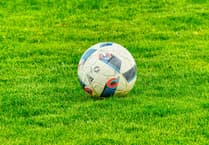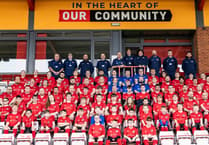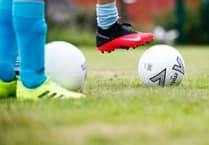IN the mid 1970’s there was a major change in club football in Devon with ambitious clubs like Dawlish Town, Heavitree United, Tiverton Town, Ottery St Mary and others progressing into the Western League. Crediton United had been bouncing up and down between the then Exeter and District League First Division and Premier Division for many years and didn’t wish to be left behind.
The Club had been playing at Newcombes Meadow regularly for 30 years but because this was a “Pleasure Park”, it would’ve been impossible to develop the ground there to an enclosed ground with changing rooms, grandstands and toilets etc.
The pitch itself had always been poor as the subsoil was clay and there were winter months when the ground was unplayable.
Perhaps, if it had been generally known that the main natural water course in the town – the Litterburn - actually flowed underground down one side of the pitch, we might have been able to install a more effective drainage system.
A GREAT CHANCE
However, the opportunity of moving to the newly-formed sports ground at Lords Meadow was a great chance for the Club’s ambitions. In the summer of 1976 the new ground and changing facilities at Lords Meadow had been built, the pitches levelled, drained and grassed.
The facilities at Lords Meadow were able to be developed due to a massive stroke of luck.
Sometime previously the Tiverton District Council had acquired the adjacent ground where the Willow Walk, Broseley Homes estate was eventually built.
Prior to the Council purchasing the fields there had been substantial wet areas against the hedge and ditch southern boundary. It was assumed that these very wet areas, which quite often resembled permanent ponds, were too wet for housing development.
This fact must have been taken into the valuation when the Council purchased the fields. By the time the Council offered the field up for sale they had drained the wet areas and found the ground to be perfectly fit for building and this increased the selling value of the site significantly.
WILLOW WALK
As a result the Council benefitted considerably when it was valued and sold to the Willow Walk – Broseley Homes constructors. With the additional profit made from the sale of the land the Tiverton District Council decided to use the money to finance the development of the Lords Meadow Sports ground.
The large field, which in years gone by had been the soakaway run-off from the town sewerage works, was developed to provide the hard standing hard court area, two football pitches and a rugby pitch at the lower end of the field.
In addition to this a concrete cricket wicket was included between two football pitches with a matting wicket to play on as well as a young children’s play area. And they had a large area used as a car park where the Sports Centre was eventually built. The entire playing area was “herring bone” drained with clay pipes and almost two feet of drainage stone and the trenches five metres apart. The whole scheme was a substantial development.
SOLD
During the summer of 1976 we had been preparing for the move to Lords Meadow and were able to sell the former small wooden Club room from Newcombes to Halwill Football Club and the showering boiler and equipment to Halwill F.C.
We even managed to sell the old goalposts to the Tiverton Council for £50 and a small storage shed for £15. But now our new ground was ready for use.
To celebrate the opening of the new ground, in 1976, the first match was arranged by a former player and committee member, Trevor Scott.
Trevor was friends with the captain of Bristol City, Trevor Tainton, then a top “First” Division (now Premier League) Club who had been granted a “Benefit” season with his Club. Bristol City agreed to bring down a full Bristol City first team squad as part of his benefit year in exchange for a donation of £500 towards Tainton’s benefit.
ENTERTAINING
The match attracted a large crowd to watch an entertaining game. City won 5-1. After the game the two Club’s teams, officials and members were able to enjoy refreshments and drinks at a very memorable function at the Rugby Club and the day proved very profitable for the Football Club funds.
The Tiverton Council in its wisdom had marked out the main pitch to a near maximum size allowed of more than 120 metres by nearly 80 metres. Even for the Bristol players this was a big pitch and in the hot weather of August 1, 1976, they were exhausted also. The Club asked to have the goalposts re-sited before the league season commenced.
The following weekend both first and second teams opened their season with double fixture home games against Newton 66 – but lost both games 3-2 and 5-2.
A few weeks later the first team manager Ken Granger had to resign for personal reasons so it was decided that team selection was overseen by captain Chris Gillard and Committee members who had been present at the previous match.
In January 1977 Fred Davey was appointed as the new team manager and held the position for two seasons.
HELPFUL
In the early years all the sports facilities could be hired by any organisation and for Crediton United there was no “sole use” agreement. The Tiverton District Council were however always helpful particularly as we had direct contact with and help from the Council’s senior representatives hierarchy.
They were also fortunate to have help from Mr Les Blake, who had been the Crediton Urban District Council town surveyor before amalgamation with Tiverton.
Once the football was underway the Club set its sights on building a Clubhouse on the ground. Loans were negotiated with the Tiverton Council and Whitbreads Brewery and by way of members and supporter’s loans.
CLUBHOUSE PLAN
A Clubhouse building plan was drawn up by Dave Treadaway, planning permission was secured, and prices for the construction obtained. In the end Club player Geoff Lee was awarded the contract and building began in late 1978 with the help of Ian Grinney, John Twitchin, Roy Edwards, Doug Dawe and George Frost.
Building was completed and an official opening held on Friday, May 18, 1979 by Mid Devon District Councillor Charlie Hawkins and Crediton Town Councillor Mary Blamey. Many former United players and supporters attended including pre-war player.
The opening of the Clubhouse started a frantic five-year period with the Club’s popularity and success exceeding members wildest dreams.
Much of the enthusiasm for the Club’s project was down to Ian Grinney and Dave Blanchford’s dreams for the Club.
A bar rota system was filled by players and volunteers and within a short time a three month rota was set up to cover match days, discos, members evenings and outside functions.
Such was the success that the club committee had plans drawn up for an extension to the Clubhouse to provide a lounge bar. This did not materialise though. The Club used to alternate weekly with the Rugby Club discos and there will be many people now approaching 50 who will recall the great times they had at both.
EXPANSION
The surprising amount of support that the Club committee realised they were receiving gave enthusiasm to fulfil plans for the Club’s expansion only previously dreamed about.
The next five seasons saw major developments for the Club. A lease extension was obtained from Mid Devon District Council to include the playing area so that the Club would have the sole use of the ground and the Council were sympathetic to most of the Club’s plans.
FLOODLIGHTS
Floodlights on the hardcourt training area were installed thanks to a grant from the F.A. and the playing area enclosed with handrails. The grandstand, a copy of Willand Rovers stand, was built by Conibear Bros and some 126 trees planted around the pitch perimeter, many of which were sponsored by Club supporters.
A wooden shed large enough to provide refreshments and accommodate a gateman was purchased.
The whole ground was finally enclosed with a tall fence which had previously been protecting the Nuclear power station at Hinkley Point in Somerset.
In 1982 the Club purchased the farmer’s field at Creedy Bridge, officially known as Bellamy Marshes to convert to two football pitches for the sum of £21,000 partly funded by another F.A. Grant.
By now the Club was running three adult teams and four youth teams from Under 11’s to Under 18’s so the need for extra pitch space was essential.
FIVE TEAM MANAGERS
On the playing side between 1979 and 1985 the first team had no less than five team managers although a couple had had to resign due to work relocations. These were Trevor Scott, Brent Howard, Ray Casling, Nigel Howe, Adrian Board and Ray Casling again. At one stage in this period the possibility of joining the South Western League covering Devon and Cornwall was considered with Nigel Howe in charge and also the prospect of the new Devon League being an option was considered.
In the end both were discounted and life continued on in the Senior 1A. Adrian Board took the job on as a player-manager for the 1983-4 season and finished in a respectable seventh place.
Adrian was in charge at the start of the 1984-5 season but after a poor start the first team were embarrassingly beaten by a 6-1 defeat in the Devon Senior Cup away at Lapford.
Adrian decided to stand down from the job and Ray Casling, one of the best players and managers ever to be involved at Crediton, took over the reins once again. With Ray in charge the team finished the 1984-5 season as runners-up in Division 1A and the team was promoted to the Devon and Exeter League Premier Division.
Ray had intended to continue the following season but an unexpected relocation of his work as an estate agent to Bristol meant that he had no choice but to resign the position. Luckily this occurred in the summer break and the Club was not in any hurry to appoint a replacement.
The manager’s position was advertised and applicants interviewed. Former Exeter City and Peterborough United player Trevor Atkins, who had previously been manager of South Western League team Clyst Rovers, was appointed.
And so began another new era.
Chris Gillard




